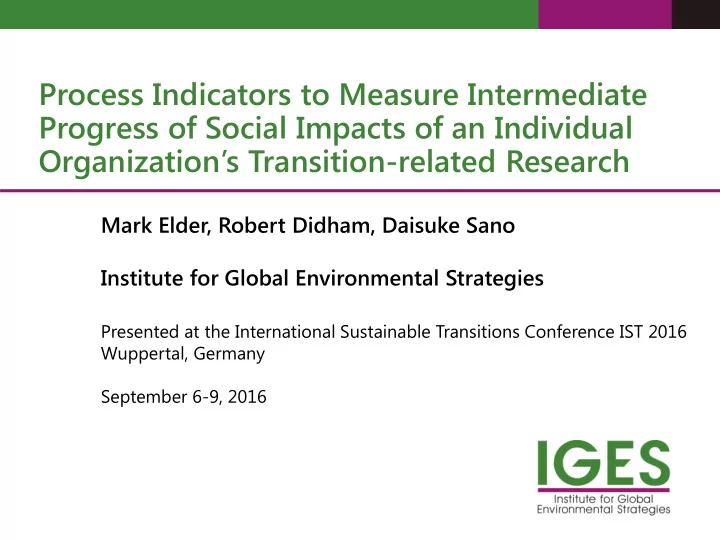

Process Indicators to Measure Intermediate Progress of Social Impacts of an Individual Organization’s Transition-related Research Mark Elder, Robert Didham, Daisuke Sano Institute for Global Environmental Strategies Presented at the International Sustainable Transitions Conference IST 2016 Wuppertal, Germany September 6-9, 2016
Introduction • It’s difficult to assess social impact of transition research (especially in the short term) • This paper develops an assessment framework which classifies the different stages or process of impact generation and proposes intermediate process-based indicators drawing on this framework. • We hope this will be practically useful to help organizations to plan more effective strategies and demonstrate intermediate results well before final impacts are visible. • This paper assessed the applicability and usefulness of this framework based on a comparative case study of five completed projects at IGES that have all resulted in a certain level of impact 2
Existing project assessment frameworks, challenges Frameworks Description OECD/DAC Relevance, effectiveness, efficiency, impact, and sustainability Balanced Scorecard From financial management to performance management Results Based Assess situation, define causes & objectives, plan actions, define Management (RBM) resources & timeline, implement & adapt, review & lessons. resources/inputs activities outputs outcomes impacts LogFrame Challenges of Measuring Social Impacts Causality Difficult to establish peer review Attribution Different fields use different methods Collective nature of achievements There is not just one successful model Timescale Impacts are not always positive 3
Results Chain of the IGES Impact Generation Strategy Outputs Outreach Outcome Level 1: Recognition of IGES Expertise Outcome Level 2: Support expanding IGES Initiative & Follow-up Outcome Level 3: Stakeholders act on IGES proposals Impact Level 1: Changes in Policy, Planning & Practice Impact Level 2: Changes in Wider Society 4
Cases Cases 1. Making Land-Use Climate Sensitive (Philippines) Integrated watershed management, land use planning • 2. Action Research Project to Develop a National Quality-of- governance Standard for REDD+ and the Forest Sector (Nepal) 3. Technology Transfer (India) Energy saving/ heat pumps, small & medium enterprises • 4. Green Gift (Japan) Tax exemption • 5. Composting (Asia) For municipal solid waste management • Rationale for Case Selection Limitations of Case Selection Achieved a certain level of impact Small number of cases Variety of activity types No cases with limited no impacts/outcomes Variety of impact generation strategies No cases where support was withdrawn Data availability (newer cases) 5
Summary of Basic Elements of Cases Short title Making Land- Forest Technology Green Gift Composting Use Climate Governance Transfer Sensitive Standard Location Philippines Nepal India Japan Asian cities Target level/ City level National level Small and National level City level stakeholder and Community medium Forest Groups enterprises Researchers, policy Policy makers Private sector, Policy makers on Policy makers (city)/ Target makers (city)/ local (national)/ forestry policymakers, finance (national)/ local residents audience/ residents stakeholders general public general public beneficiaries Increased Improved forest Low carbon tech Increased inv. in Improved Expected/ resilience to sector livelihoods adoption, GHG low-carbon tech., livelihoods of actual impacts climate change reduction GHG reduction residents Univ.of the Griffith U, U. The Energy and Gained the UNESCAP, Partners Philippines Los Southern Resources support of Japan’s municipal Banos; municipal Queensland, Min. Institute (TERI) parliament governments governments Forests & Soil members Conservation (MoFSC) of Nepal Timeline 2014-2015 2014-present 2009-2012 2013-2015 2000-present 6
Outcome Level 3, Impact Level 1 Outcome Level 3: Action by Stakeholders Land use 4 local governments established an Integrated Watershed Management Council for harmonizing land use planning across the watershed. REDD governance The Quality-of-Governance standard has been piloted. Tech. transfer Pilot projects were implemented and some technology was transferred. Green gift Policymakers came to support the plan. Composting Pilot projects implemented; policymakers decided to adopt the system. Impact Level 1: Changes in Policy, Planning & Practice Land use Local governments are applying adaptation countermeasures in their land use plans and implementing them in practice. REDD governance In process. Government of Nepal is considering adopting the new Governance standard and incorporating it into its Community Forestry Guideline. Tech. transfer Some Indian companies decided to use the piloted technology. Green gift The green gift tax plan was enacted into law in Japan. Composting The composting system was adopted by a few cities. 7
Process Indicators Relating to Preparation, Outputs, and Outreach Process Indicators • Preparation The research plan was based on collaborative partnerships. • Appropriate target stakeholders and policymakers were identified and relevant impact generation plan was developed. • Initial project plans were modified based on feedback from stakeholders. • Outputs Outputs relevant to stakeholders were generated. • Outreach Outreach was conducted with stakeholders (co-design and co-production) through workshops, focus groups, field research, onsite visits, and advocacy. • Validity of generated knowledge was tested through stakeholder engagement. 8
Process Indicators Relating to Outcomes Outcome-based Activity-based • • Concrete indications of stakeholder Use of stakeholder co-design and co- Outcome recognition of IGES expertise. production of research Level 1 • Evidence of changed stakeholder perceptions resulting from IGES initiatives • • Concrete indications of stakeholder Ownership by stakeholders was Outcome support for further expanding promoted through the use of Level 2 activities. pragmatic and consensus validation to • Stakeholders engage in cooperative test the validity of generated action or partnership with IGES. knowledge. • • Evidence of actions taken by Continuity of project team’s activities Outcome • stakeholders Steps taken to formalize and Level 3 • Expansion/replication of institutionalize stakeholder actions activities/pilot projects to new sites such as forming a committee and locations. 9
Conclusions • Overall, the IGES framework seems useful to track the progress of generating outcomes and impacts. • The framework was broadly applicable to a variety of types of projects, including both local and nationally focused projects • However, it may not be easy to use this framework directly to make decisions about continued implementation of the project. • Finally, this paper points to the importance of further study of longer term outcomes and impacts. 10
Thank You! www.iges.or.jp 11
Recommend
More recommend